Compiled by Geoff Goodall
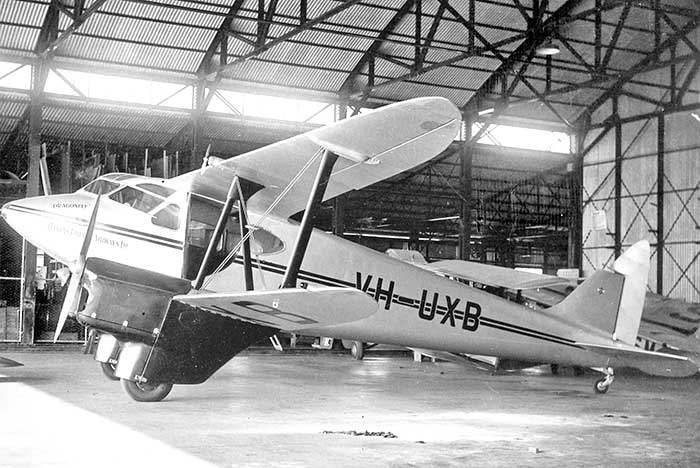
This picture was taken in October 1936 immediately after assembly by Qantas at Brisbane
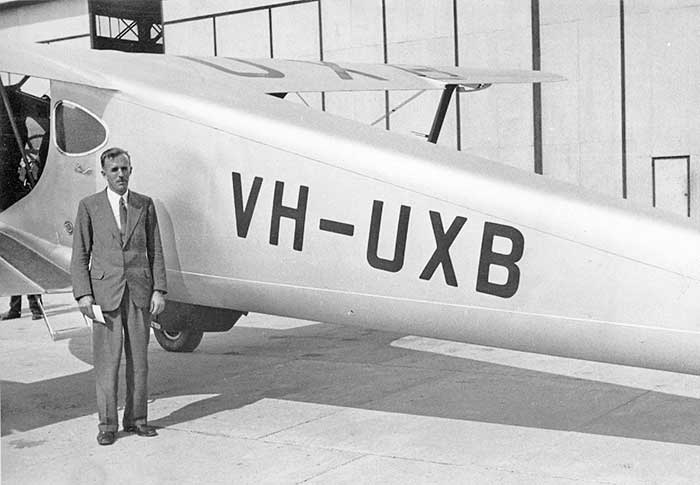
Both heading photographs: Qantas, via Frank Walters collection
The De Havilland Aircraft Co Ltd envisaged the 5-seater DH.90 Dragonfly as a luxury privately-owned touring aircraft at a time when the world had come out of the The Great Depresssion and business optimism was high. Resembling a scaled-down DH.89 Rapide, it was in fact of very different construction: the fuselage was a monocoque schell of pre-formed ply with light spruce stringers. A similar technique was used for the DH.88 Comet racers and the DH.91 Albatross airliners.
The Dragonfly's attractive design of tapered wings, sleek fuselage and pointed tailplane resulted in a much improved performance to the Rapide and many other refinements. Dual controls were provided for the two front seats, the cabin having a double seat at the rear and a fifth seat in the centre. Engines were the popular 130hp DH Gispy Major 1
The first flight of the prototype DH.90 was at DH's home airfield Hatfield in August 1935. Interest was high and early orders placed by prominent Lords, Barons and Sirs, wealthy British and French businessmen and even foreign Kings. The production line at Hatfield built a total of 66 Dragonflies over the next three years. After the initial sales to private owners as luxury runabouts, the DH.90 proved more suitable for commercial operation - its 4 passengers seats making it an obvious step-up for DH.83 Fox Moth operators.
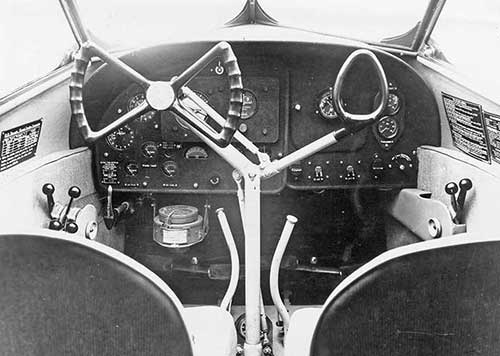
DH.90
cockpit.
Photo: Ben Dannecker collection
Six Dragonflies were imported to Australia,
all leading adventurous lives. Qantas operated two on western
Queensland services and during the war additional military charter
work. Connellan Airways at Alice Springs flew two on their remote
services to outback small towns and cattle stations in NT, WA and
Queensland. Two Australian DH.90s later flew back to England. In Australian operation, the Dragonflies had one consistant design failure - the tendency to swing violently during takeoff or landing ("ground-loops"), which usually caused significant damage to the wooden structure. Pilots of the day were well used to the possibility of losing directional control of any tailwheel aircraft, but the DH.90 was particularly skittish. Dragonflies were out of service for several months of repairs following ground-loops all over Australia. At the end of the war, the Department of Civil Aviation reviewed recent ground-loop events, expecting to find pilot inexperience on type - but instead found that airline pilots with extensive experience on the Dragonfly could be caught by the gust of wind at the wrong time just the same as less experienced.
E.J.Connellan, founder of Connellan Airways later wrote of his introduction to the DH.90:
"The first of our new aircraft types after the war was the Dragonfly VH-UTJ. It had been damaged in a ground-loop with Qantas, and Captain Forgan-Smith, a senior Qantas pilot, delivered it to us at Alice Springs. He impressed on me that the aircraft was very prone to ground-loop and it was necessary to rely on brakes and to keep the aircraft running straight and not use engine power. This was contrary to the technique I had developed to meet the same problem with the Percival Gulls. I insisted on spending a whole day taxying around. I would taxy to a certain speed then deliberately ground-loop it, at a speed below that which would cause damage. I became satisfied that his technique was correct. In that way I never ground-looped the type and minimised the number of times that our pilots did so."
DH.90 production ceased in 1938 and the jigs and specialised tooling were stored at DH's Hatfield works until discarded in June 1940 to become effective wartime road blocks on the Barnett bypass road near Hatfield.
|
36 | Built at Hatfield by De Havilland Aircraft Co Ltd. Production DH.90 |
| 21.10.36 | British CofA issued |
| Ordered new by De Havilland Aircraft Pty Ltd, Sydney for customer Fostar Shoes Air Transport Pty Ltd, Sydney NSW | |
| Civil Aviation Board issued registration VH-UXA which was painted on at the Hatfield works | |
| DH records show that DH.90 c/n 7538 was assigned to the VH-UXA order, but changed on the production line to c/n 7533. (7538 went to Canada as CF-MPD for the Canadian Mounted Police) | |
| Shipped as boxed cargo to Australia | |
| 1.37 | Assembled at Mascot Aerodrome, Sydney by De Havilland Aircraft Pty Ltd. Fuselage paijnted light blue, wings silver. The cabin has seating for 4 passengers and was upholstered in light grey morquette |
| 24.1.37 | Registered VH-UXA: Fostar Shoes Air Transport Pty Ltd, Sydney NSW Fostar Shoes Pty Ltd was a long-established Sydney shoe manufacturer, which went on to produce large orders for military boots during WWII. Forstar Shoes was owned by Sydney businessman John Henry "Frank" McEvoy The air transport subsidiary was reported in newspapers as planning to carry latest model shoes to Cairns via towns en route, giving express delivery of shoes. It would eliminate the current long delays by railway then coastal shipping. Inaugural pilot was Captain Frank Neal, experienced Australian commercial pilot. |
| 24.1.37 | CofA issued at Mascot. Named "Cettien" |
| 2.2.37 | Arrived
Cairns on the inaugural Sydney-Cairns shoe delivery service, carrying
two Fostar Shoes managers as well as the shoe consignment. Flown by experienced pilot Captain Frank Neal who has been employed by the company to operate their aircraft. |
| 24.5.37 | VH-UXA
departed Mascot for a private flight to Hong Kong. Pilot Frank Neal
carried owner McEvoy and his family on a holiday trip |
| 7.7.37 | Returned to Sydney from Hong Kong |
| For
the pending Mackay Aerial Expedition, VH-UXA had a 25 gallon auxiliary
fuel tank installed in the rear of the cabin, which reduced the cabin
seating from 5 to 3. DeHavilland Aircraft Pty Ltd at Mascot installed bulky radio transmitter and receiver equipment, | |
| 17.7.37 | Local flight over Sydney to test the radio, which was heard by ground stations as far away as Queensland |
| 19.7.37 | G-AEDG and DH.80 Puss Moth VH-UQB departed Sydney to commence the fourth and last "Mackay Aerial Survey Expedition of Central Australia", financed by explorer Donald Mackay. The Dragonfly was chartered from Fostar Shoes, flown by Frank Neale, who had flown on previous Mackay expeditions. |
| 23.7.37 | VH-UXA reached the expedition base camp in the Tanami Desert WA. There was a delay using the radio equipment because there were no trees to hang the ground station aerials. Poles were brought in by camel train. |
| 23.8.37 | The Dragongly and Puss Moth returned to Sydney on completion of the survey |
| Made private flights to Netherlands East Indies and Malaya | |
| 23.2.39 | VH-UXA
departed Mascot on a holiday flight to England and Europe for Fostars
Shoes' Managing Directore Harry McEvoy and his family. Pilot Captain
Frank Neal. |
| 28.2.39 | Departed Darwin. Mr. McEvoy told press that his family wanted to ski at the St Mortitz snow fields in Switzerland. |
| VH-UXA sold in England | |
| 15.4.39 | Registered G-AFTF: Eric E. Noddings, Chipstead, Surrey. Based at Croydon |
| 39 | Operated by Air Dispatch Ltd in camouflage paint. One of six DH.90s operated |
| 19.12.39 | Crashed at Shoreham, operated by Air Dispatch Ltd. Repaired |
| 27.5.40 | G-AFTF delivered to Ringway aerodrome, Manchester to be handed over to RAF |
| 5.40 | Impressed by British Government for RAF communications duties |
| 8.40 | Taken on RAF charge as BD149 |
| 8.40 | Issued to No.8 Group Anti-Aircraft Cooperation Unit (8AACU) |
| 21.5.42 | Struck-off RAF charge |
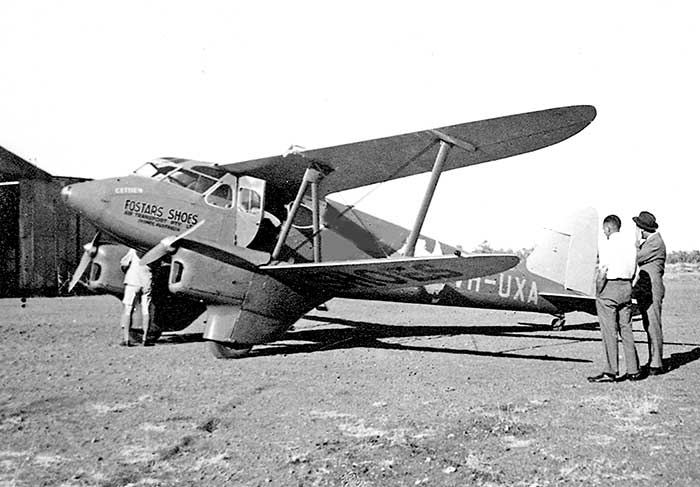
Photo: Ben Dannecker collection
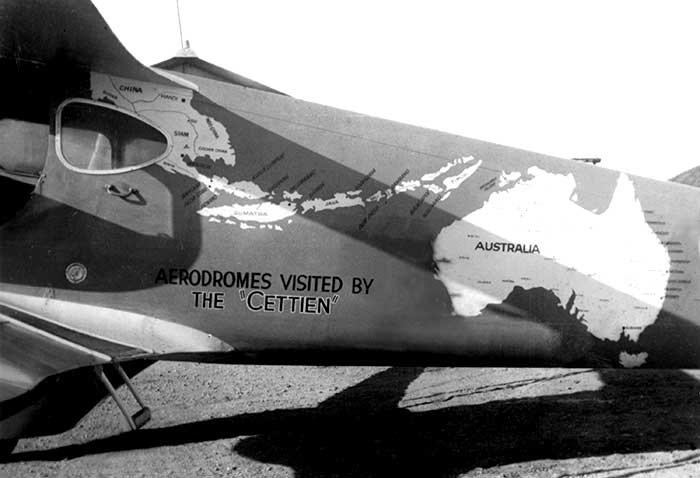
Photo courtesy John Lewin, thanks to Ron Cuskelly
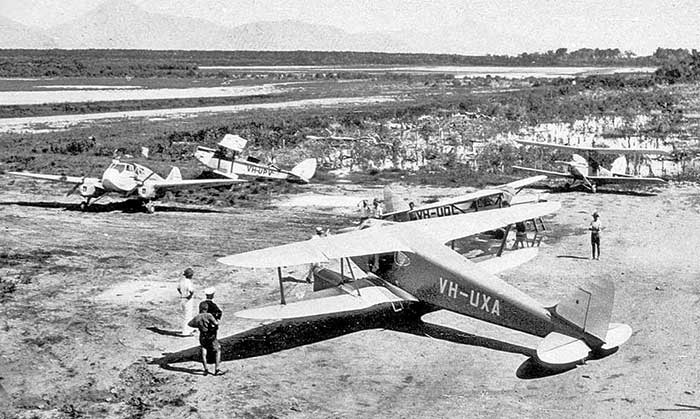
VH-UXA on a shoe delivery run from Sydney has changes to its paint scheme. Photo: State Library of NSW
| 36 | Built at Hatfield by De Havilland Aircraft Co Ltd. Production DH.90 |
| Ordered new by Qantas Empire Airways Ltd, Brisbane Qld | |
| Civil Aviation Board allocated registration VH-UXB, which was painted on at the factory | |
| 6.8.36 | British CofA issued Hatfield as VH-UXB: Qantas Empire Airways Ltd, Brisbane Qld |
| 9.36 | Shipped to Australia as boxed cargo on board SS Mooltan, expected at Brisbane 5.10.36 |
| Assembled by QEA at Archerfield Aerodorme, Brisbane | |
| 23.10.36 | CAB Inspection report Archerfield after assembly |
| 26.10.36 | Registered VH-UXB: Qantas Empire Airways Ltd, Brisbane Qld |
| 26.10.36 | Australian CofA issued |
| Entered
Qantas service on their extensive network of services to towns and
station properties in outback Queensland and inland routes to Darwin. | |
| Numerous minor accidents and forced landings | |
| 25.12.38 | Undercarriage collapsed when swung violently during takeoff run at Mount Isa Qld. Captain E.G. Donaldson unjurt |
| 20.11.40 | Forced landing Daly Waters NT after a bird struck a propeller, Captain C.H.C.Swaffield |
| 5.1.41 | Minor damage when struck soft ground at Longreach Qld, Captain C.H.C.Swaffield |
| 19.6.41 | Forced landing 15 miles west of Alexandria MT when part of a propeller broke away in flight. Captain C.H.C.Swaffield |
| 7.2.43 | Forced landing Wondai Qld while on charter to Allied Works Council, Captain W.Forgan-Smith |
| 28.4.43 | Forced landing 35 miles south of Daly Waters NT due engine failure while being ferried from Batchelor NT to Archerfield. Captain W.Forgan-Smith. Aircraft was moved overland to Daly Waters aerodrome for repaiur |
| 8.5.43 | Tail
section torn off during a forced landing 37 miles south east of
Daly Waters NT due smoke in the cabin from an electrical fault. Enroute
Cloncurry to Darwin on charter to US Army, Captain W. Forgan-Smith and
one passenger. Dismantled at the site and moved overland to Daly Waters aerodrome for temporary repair, then ferried Daly Waters to Archerfield for rebuild of the tail section by QEA |
| 13.7.43 | Ground-loop
on takeoff at Archerfield Qld caused the port undercarriage to collapse
and the wing spars were cracked. Captain J.A.Bird |
| 13.10.43 | While
taxying at Cloncurry for departure, a passenger threw a penny coin out
of the window. It struck a propeller and was flicked back at the
fuselage, cutting a hole through the cabin wall. Repair of the damage delayed the Normanton mail Service. |
| 7.44 | QEA base DH.90s VH-UXB & VH-UTJ at Charlevelle and Cloncurry respectively for the Flying Doctor Service contract. |
| 28.1.46 | Ground-loop during landing at Cloncurry Qld on a Flying Doctor Service of Australia flight. The port undercarriage collapsed. QEA Captain I. F.McSparrow was returning from Mitchell River Mission, carrying Dr.Alberry of the Cloncurry FDS Base and two aboriginal patients. After temporary repair to undercarriage, port wing, and bent propeller, UXB was ferried to Archerfield for permant repair. Replaced at Cloncurry by DH.83 Fox Moth VH-UZD on the Normanton mail service. |
| 9.3.46 | Inspection of wing spar at Cloncurry Qld found a serious crack. Repaired. |
| 16.1.47 | Serious
damage due ground-loop on takeoff at Cloncurry Qld. Undercarriage
structure bent, propeller broken, centre-section spar split. QEA
Captain W. Forgan-Smith was instructing First Officer W.E.Morton, who
was making his first flight in the type. |
| 25.2.47 | Change of ownership: Edward J. Connellan, trading as Connellan Airways, Alice Springs NT Purchased while u/s at Cloncurry. |
| Eddie Connellan sent one of his engineers Ivan Hewitt to Cloncurry to repair VH-UXB. Over a number of weeks, he rebuilt the cabin floor, fitted a new port undercarriage structure, replaced the engines and installed new rear engine cowlings. | |
| 24.4.47 | Cloncurry repair completed. CofA renewed 24.4.47 |
| 5.47 | Commenced airline service with Connellan Airways, based at Alice Springs |
| .50 | Retired by Connellan Airways Based on a listing of Connellan aircraft compiled in the 1980s by Eddie Connellan |
| 14.3.51 | Change of owner's name: Connellan Airways Ltd, Alice Springs NT |
| 17.9.51 | Struck-off Register. Cancelled by DCA during their 1951 Census of unairworthy aircraft which would be deleted from the Civil Register. |
| - | Sold to Thomas H. McDonald, Cairns Qld Based on a listing of Connellan aircraft compiled in the 1980s by Eddie Connellan. Tommy McDonald, a Cairns jeweller, pioneered air services in Far North Queensland in 1935 with DH Puss Moths , later founding North Queensland Airlines Pty Ltd which had grown to DH.Dragons and a DH.Rapide before selling out to Airlines of Australia in 1939. He used DH.90 VH-UXS as his own aircraft, before and after WWII but sold it in 1945. |
| c55 | Report: Stored dismantled in Connellan Airways hangar at Townsite Aerodorme, Alice Springs. |
| The
circumstances of Tom McDonald's acquisition of the retired VH-UXB at
Alice Springs have not been ascertained - nor whether he had it moved
from Alice Springs for a planned rebuild. However it did not return to
the Civil Register. |
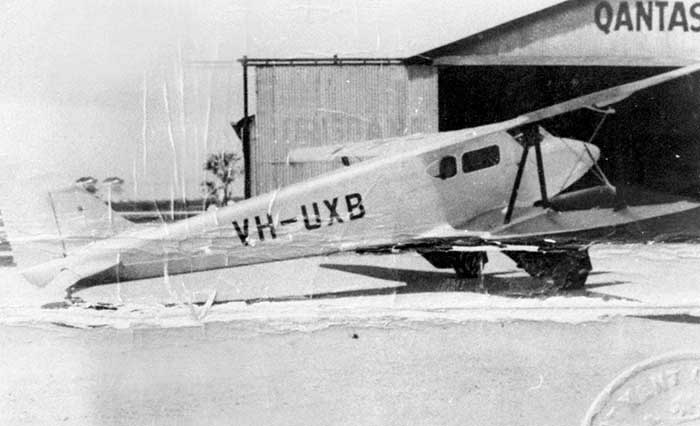
showing the new aircraft at Brisbane prior to Qantas markings being painted on the nose.
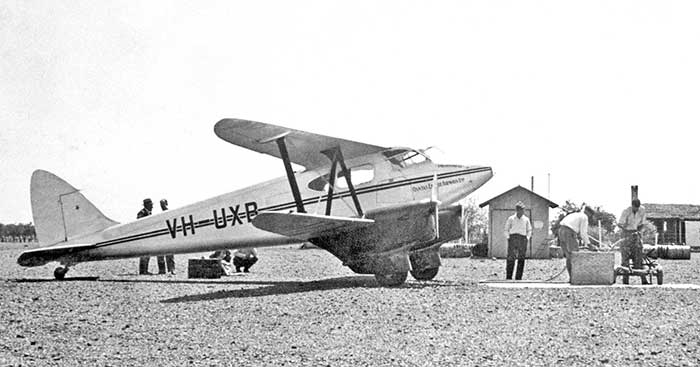
"Qantas Empire Airways Ltd" and "Dragonfly" on the nose. Photo: Neil Follett collection
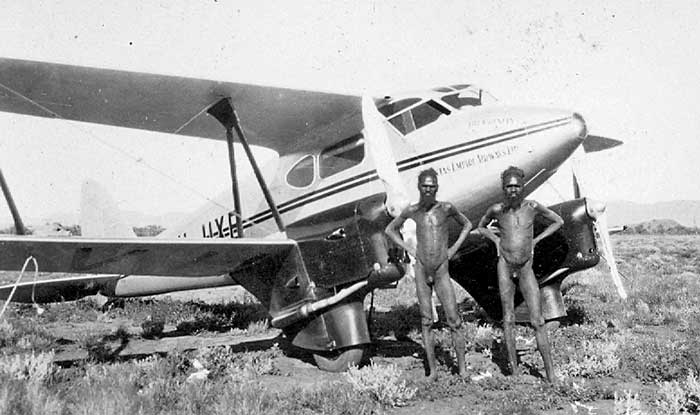

on the tail and name on nose. It was purchased "as is" by Eddie Connellan and rebuilt at Cloncurry.
Ben Dannecker collection
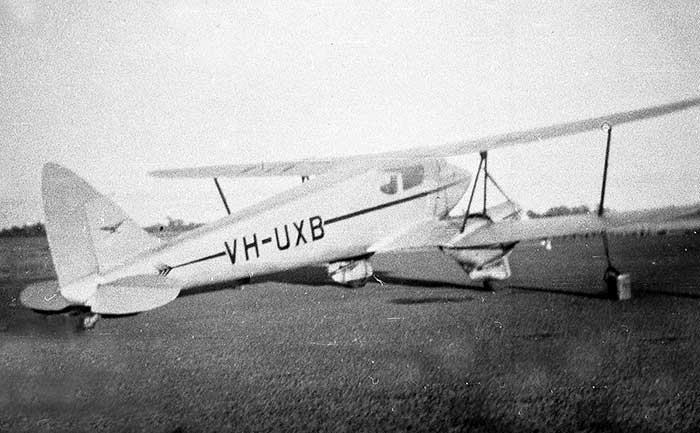
| 12.36 | Built at Hatfield by De Havilland Aircraft Co Ltd. Production DH.90 |
| Ordered by Australian DH agents De Havilland Aircraft Pty Ltd, Sydney for customer Southern Airlines and Freighters Ltd, Melbourne Vic. | |
| Civil Aviation Board allotted registration VH-UXS which was painted on at the factory | |
| 18.1.37 | First flight Hatfield |
| 1.37 | British CofA issued as VH-UXS: De Havilland Aircraft Pty Ltd, Mascot Aerodrome, Sydney |
| Southern
Airlines and Freighters Ltd was
founded in Melbourne in December 1936 by Ian Grabowski, who went on to
a long career with Australian
airlines. SAL&F had ambitious plans to fly Melbourne-Adelaide with
7 Junker Ju 86s, but was offered the Sydney-Broken Hill route just
abandoned by WASP (Western & Southern Provincial Airlines Ltd) and
their remaining aircraft. Another company Intercity Airways Pty Ltd was formed in Sydney in February 1937 to take over Sydney-Broken Hill (via enroute stops). The route would not support two airlines, and in July 1937 Intercity Airways Pty Ltd amalgamated with SAL&F. The combined operation, known as Southern Airlines, commenced 30.7.37 on an airline route Sydney-Nyngan-Broken Hill using a Tugan Gannett VH-UVU, Codock VH-URP and Dragonfly VH-UXS. SAL&F held the Aeronca agency and imported two Aeronca 100s. | |
| Shipped to Australia | |
| 7.37 | Assembled by De Havilland Aircraft Pty Ltd at Mascot |
| 2.8.37 | First test flight Mascot after assembly, pilot Alan Murray-Jones of DH Aircraft Pty Ltd |
| 5.8.37 | Australian CofA issued |
| 5.8.37 | Added to Civil Register as VH-UXS: Southern Airlines and Freighters Ltd, Melbourne Vic |
| 12.8.37 | Undercarriage collapsed on takeoff at Cobar aerodrome NSW. Pilot J.A.Neville-Jackson was not hurt but aircraft badly damaged. Moved by road to Sydney for repair |
| 13.10.37 | Testflown Mascot by Allan Murray-Jones after rebuild by De Havillad Aircraft Pty Ltd |
| 10.37 | Ian Grabowski of SAL&F wrote to CAB requesting that the airfields at Wilcannia and Mudgee have their rough surfaces improved so that his airline could operate into these towns. |
| 14.1.38 | Undercarriage structure bent on takeoff from Dubbo NSW due soft airfield surface. Pilot Sid deKantzow had flown SAL&F Manager Ian Grabowski from Sydney to Dubbo for talks with the Dubbo local council to find a site for a new airfield for the town. Sid deKantzow had previous flying experience in New Guinea. In 1938 he began flying for a British airline and during WWII flew for the Atlantic Ferry Service and China National Aviation Corp. In 1946 he was joint partner with American Roy Farrell to establish the Roy Farrell Export-Import Co which flew C-47 freighters from Hong Kong to Sydney and became Cathay Pacific Airways. |
| 1.38 | De Havilland Aircraft at Mascot flew replacement undercarriage parts to Dubbo ,with engineers to repair the aircraft. |
| This
was the final straw for Southern Airlines and Freighters Ltd, which
ceased operations effective 9.2.38 and was placed in liquidation. The airline had added new ports along its Sydney-Broken Hill route and tried an extension from Broken Hill to Mildura Vic, but was unable to build a viable business | |
| 11.10.38 | CofA expired, not renewed. Parked at Mascot while liquidators sought a sale |
| 21.7.39 | Change of ownership: Thomas H. McDonald, Cairns Qld Tommy McDonald, a Cairns jeweller, pioneered air services in Far North Queensland in 1935 with DH.80 Puss Moths , later founding North Queensland Airlines Pty Ltd which had grown to DH.84 Dragons and a DH.89 Rapide before selling out to Airlines of Australia in 1939. |
| 20.8.39 | Test flown at Mascot by Frank Neale, after CofA renewal inspection by S. D. Marshall of Marshall Airways, Mascot. |
| 31.8.39 | CofA renewed by DCA |
| VH-UXS
now based Cairns. McDonald hired experienced commercial pilot and
engineer Charles Gatenby to operate the aircraft for charter. | |
| 23.4.40 | Damaged on landing at Batavia strip, Wenlock on Cape York Peninsula. A wind gust as the aircraft was flairing blew it off the dirt strip and the undercarriage struck stumps of trees which had been felled to clear the strip. Pilot Charles Gatenby was unhurt but aircraft suffered seriously damage. |
| 6.40 | DCA
memo: VH-UXS is being rebuilt at the crash site. Required parts
including new wing spars have been sent by rail to Cairns by De
Havilland Aircraft Pty Ltd at Sydney. |
| 7.40 | Tom
McDonald wrote to DCA asking if his DH.90 VH-UXS would be immediately
impressed for the RAAF when its rebuild was completed. Two months
earlier he had purchased DH.84 Dragon VH-ABK from South Queensland
Airways only to have it impressed by the Government. DCA gave a
non-commital response. However DCA internal memos discuss the Department's plan that under wartime provisions, DCA will issue VH-UXS to Butler Air Transport, Sydney to replace their DH.84 Dragon VH-URV has been impressed for RAAF. |
| 9.40 | Rebuild at Wenlock completed. Parked covered from the tropical weather by tarpaulins. In early September Tom McDonald flew his Miles Falcon VH-ACE from Cairns to Wenlock, taking a DCA aircraft inspector to check the temporary repair. Approval was given for the DH.90 to be flown empty to Cairns for formal repair. |
| 19.9.40 | Arrived at Cairns from Wenlock |
| 1.10.40 | Letter to T.H.McDonald advising that VH-UXS has been requisitioned under wartime regulations and is to be delivered
to Butler Air Transport, Sydney. This will allow BAT to maintain its
twice-weekly scheduled service Sydney-Charleville. |
| 10.10.40 | VH-UXS flew from Cairns in a search for a missing boat |
| 11.10.40 | DCA renewed its CofA after receipt of inspection reports on the Cairns repair work |
| 10.40 | McDonald was advised that the Requisition order had been cancelled |
| 28.8.41 | Undercarriage damaged when sunk in sand while taxying on a beach at Port Douglas Qld. Pilot Tom McDonald had arranged for fuel to be taken to the beach for an urgent medical flight from the north to Cairns with 4 passengers. |
| 4.12.41 | CofA renewed after repairs at Cairns |
| 16.1.42 | Impressment Requisition No.9021 for DH.90 VH-UXS served on T.H.McDonald. Aircraft is to be delivered to RAAF as per instructions to follow. |
| 6.2.42 | Cabin modified as an air ambulance by RAAF contractor Guinea Airways, Parafield SA |
| 11.2.42 | Taken on RAAF charge as A43-1. Received No.2CF Mascot ex T.H.McDonald |
| 16.2.42 | Received No.1 Aircraft Depot, Laverton ex Guinea Airways |
| 16.2.42 | Operational with No.2 Comms Flight, Mascot |
| 10.8.42 | Landing accident, port lower wing and undercarriage damaged |
| 17.8.42 | Issued 3AD Amberley for repair. On completion to be issued to No.34 Squadron |
| 21.8.42 | Issued to Aircrafts Pty Ltd, Archerfield for repair ex 3AD |
| 24.11.42 | Repair delayed while De Havilland Aircraft at Mascot manufacture parts needed |
| 22.1.43 | Assembly and repairs continuing, mainpane compression stut still required |
| 23.4.43 | Received 3AD ex APL |
| Directorate of Air Transport, Allied Air Forces allocated radio callsign VHCSA, which was painted on the aircraft | |
| 24.4.43 | Major
damage on takeoff at 3AD when ground-looped off runway, came to rest at
90 degrees to runway. Pilot LAC R.H.Sasse and 3 crew all unhurt. Airframe total time 1907 hrs. Time since last inspection: 30 mins |
| 10.6.43 | Received Parachute Training Unit after repairs completed |
| 6.12.44 | Received 3AD Amberley ex PTU for storage pending instructions re disposal |
| .44 | RAAF
advised DCA that A43-1 was available for civil disposal. DCA had a
policy of offering impressed aircraft back to their civil owner at the
time of impressment. Tom McDonald was willing to accept the DH.90 held by RAAF in "as is" condition |
| 9.3.45 | Commonwealth Disposals Commissiona advise RAAF HQ that a tender of £850 has been accepted from T.H.McDonald, Cairns Qld |
| 14.3.45 | Issued to purchaser ex 3AD Amberley |
| 4.45 | DCA
memo: McDonald has purchased DH.90 A43-1 at RAAF Amberley. Airframe
total time 2,245 hours. It is waiting to have temporary repairs carried
out at Amberley before being ferried to Archerfield for CofA renewal
overhaul. |
| 2.5.45 | Ferried Amberley to Archerfield |
| 8.8.45 | Restored to Civil Register as VH-UXS: Thomas H. McDonald, Cairns Qld |
| 9.8.45 | CofA renewed at Archerfield. An ambulance stretcher door was installed during the overhaul |
| 12.11.45 | Change of ownership: Brown & Dureau Pty Ltd, Melbourne Vic Based at Essendon. Purchased as the first aircraft for the company's newly-established aerial survey division Brown & Dureau was an established agency representing Lockheed and other aircraft manufacturers as well as mumerous aircraft parts suppliers. B&D imported all pre-war Lockheed 10s,12,14s and RAAF Hudsons into Australia. Post-war B&D expanded into aircraft maintenance at Geelong Vic, sales of RAAF disposals aircraft and a new aerial survey operation. |
| VH-UXS modifed for high level vertical photographic survey and mapping | |
| 19.8.46 | Annual CofA renewal at Essendon Vic |
| 11.12.46 | Ground-loop on takeoff at Cambridge Aerodrome, Hobart Tas. Port undercarriage damaged. Pilot E. G. Noble had 56 hrs on type |
| 28.8.47 | Annual CofA renewal at Mascot NSW |
| 20.8.48 | Annual CofA renewal at Essendon Vic |
| 7.49 | VH-UXS
noted at Essendon in hangar used by B&D Aerial surveys, parked
alongside DH.89 Rapide VH-UFF also operated on survey by B&D. |
| 7.49 | VH-UXS noted at Essendon in the hangar used by B&D aerial surveys. |
| 28.9.49 | Struck-off Register as withdrawn from service |
| 28.12.50 | Annual CofA renewal at Moorabbin Vic |
| 28.12.50 | Restored to Civil Register: Brown & Dureau Pty Ltd, Melbourne Vic. Now based Moorabbin |
| 8.3.51 | Annual CofA renewal at Moorabbin Vic |
| DCA file details end here due change in filing system | |
| 17.3.52 to 10.4.52 | Camera operator B. McCarthy logbook: VH-UXS based Wynyard, Tasmania on aerial mapping, pilot D. Burns |
| 21.7.54 | Change of ownership: R. N. Hunt, Boorooraban via Hay NSW Purchased to enter in the highly publicised first (and only) REDeX Aerial Reliability Trial to take place the following month. The route was Sydney to Brisbane, Townsville, Darwin, Alice Springs, Adelaide, Wagga, Sydney, with numerous stops enroute. |
| 1.8.54 | Departed
Bankstown Aerodrome, Sydney with the first wave of the total of 16
aircraft competing in the REDeX Trial. Pilot R. Hunt experienced
engine trouble soon after departure and diverted to RAAF Williamtown.
After replacing a magneto with one purchased in nearby Newcastle, he
continued on the first day's route to Coffs Harbour, then Brisbane. |
| 8.54 | R.N. Hunt completed the trial and won the prize for best performance by a multi-engined aircraft |
| 21.1.56 | Change of ownership: Austral Motorcycles Pty Ltd, Newcastle NSW |
| 9.4.56 | Change of ownership: Dalkeith L. (Keith) Hilder, Merewether NSW UXS used for twin-engined and IFR training, also dropping parachutists After flying Tiger Moths from a cleared area of land at Pelican Flats near Belmont, Newcastle, Keith Hilder gained approval in 1958 to establish a permanent airfield which he named Aero Pelican. Operated a flying school, in 1964 adding Aero Pelican Air Charter Service and later the Aeropelican high-frequency airline service to Sydney. |
| c57 | VH-UXS accompanied four Royal Newcastle Aero Club DHC-1 Chipmunks on a goodwill visit to Aero Club of Southern Tasmania at Hobart. |
| 11.63 | noted at Bankstown, visiting, pale blue and white "Sabrina" on nose. (The name "Sabrina" was no doubt because the pointed nose was reminsiscent of a popular early 1960s buxom blonde movie star of that name.) |
| 6.9.64 | noted
at an airshow at Aero Pelican, pale blue and white. Company name "Aero Pelican" was
painted on the fuselage sides, "Sabrina"on the nose |
| 20.5.65 | Change of ownership: L. G. Randall, Shoal Bay NSW |
| Leased to R. H. Healy, RAAF Base, Darwin NT. Used for parachuting. Healy had earlier purchased DH.89 Rapide VH-ECW in January 1963 for parachuting at Darwin. However an overhaul at Parafield SA a year later found problems that made the overhaul too expensive, and he left at Parafield for resale. The Dragonfly was leased to replace the Rapide, but indications are the DH.90 was not flown for long in Darwin. R.H. Healy was killed in a crash of his Beech 35 Bonanza VH-CDU near Darwin 5.8.66 | |
| 7.66 | noted at Darwin Airport, tied down outside, weather beaten paintwork. It had been removed from its usual hangar because of outstanding hangarage fees |
| 10.10.67 | noted at Darwin Airport, tied down outside, weather beaten paintwork, looks abandoned. Inspection showed the airframe woodwork was deteriorating rapidly in the tropical weather |
| 68 | Moorabbin
Air Museum at Moorabbin Airport, Melbourne attempted to acquire VH-UXS
at Darwin, but were advised it was not available for sale because it
was planned to be returned to airworthy condition in the future. |
| 17.7.68 | Struck-off Register. Withdrawn from service at Darwin NT |
| VH-UXS rotted in the tropical climate at Darwin and literally fell to bits where it stood. It was moved to a storage area on the airport with abandoned vehicles, where the derelict fuselage was smashed by vandals | |
| 96 | Reported that parts and fittings of VH-UXS were held in NSW |
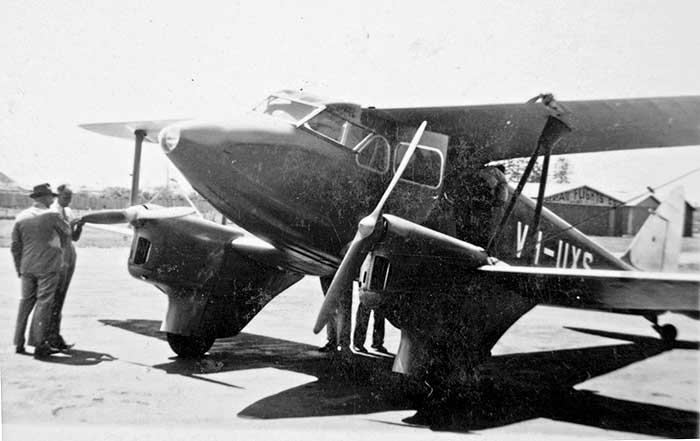

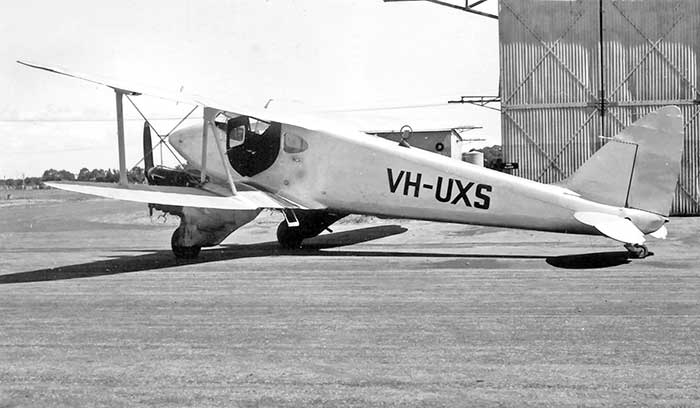

Photo by Laurie Crowley who was flying the Percival Gull in the foreground, via John Hill
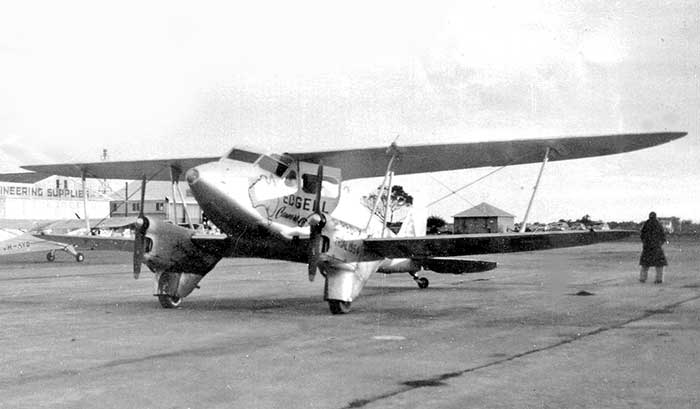
Photo by Jim Evans, via Nigel Daw collection
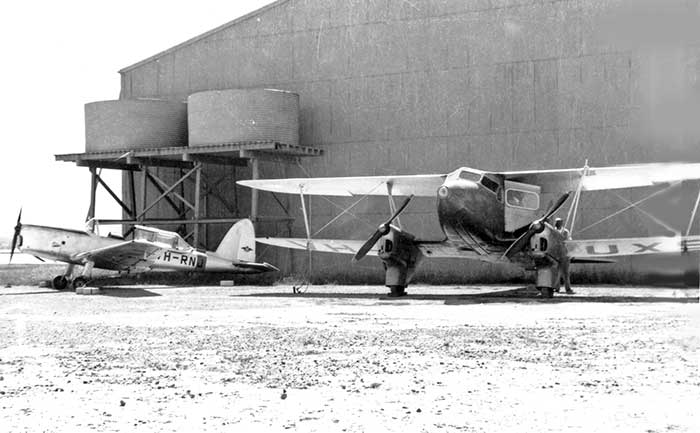
Norm Weeding's photo at Cambridge Airport, Hobart shows it with a dark coloured fuselage and silver wings
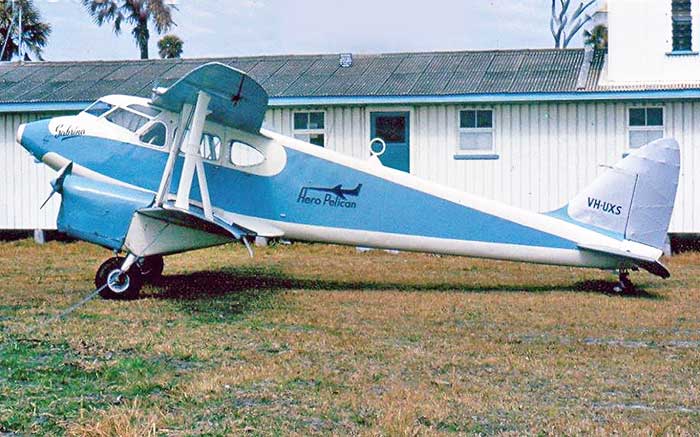

at rear left is a RAAF long-nose Lincoln in the fire-practice area. Ian Smart via Ron Cuskelly

Photo by Neil Follett

| 36 | Built at Hatfield by De Havilland Aircraft Co Ltd. Production DH.90 |
| 29.7.36 | Registered G-AEDG: James Valentine Fairbairn, London W1. Named Spirit of Flinders James Fairbairn came from a wealthy pastoralist family which was prominent in Australian business, flying and politics. In WWI James sailed to UK to join RFC and was shot down in February 1917 and taken prisoner by Germans. After winning a seat in Victorian State Parliament in 1932, he moved to Federal Parliament, flying his DH.85 Leopard Moth VH-URK between his farm and Canberra. In 1939 he was appointed to joint portfolios Minister for Civil Aviation and Minister for Air (military) as well as Vice President of the Executive Council. |
| 8.8.36 | First flight Hatfield |
| 13.8.36 | British CofA issued |
| 14.9.36 | Departed England on delivery flight to Australia by James Fairbairn with O.F.Y. (Frank) Thomas as copilot and navigator. Thomas had flown DH.80 Puss Moth VH-UQK from Sydney to England Oct-Nov 1935. He joined Qantas Empire Airways in April 1937 and went on to a long flying career with Qantas |
| 7.10.36 | G-AEDG arrived at Canberra |
| Based at Fairbairn's pastoral property Mount Elephant at Derrinallum Vic | |
| 1.9.37 | Fairbairn
wrote to Civil Aviation Board requesting an Australian registration be
allocated to his G-AEDG. CAB responded, thoughtfully offering VH-ADG, which was ahead of the current allocation sequence, but would minimise repainting of his aircraft. |
| 8.10.37 | VH-ADG painted on aircraft at Essendon |
| 12.10.37 | Added Australian Register VH-ADG: James V. Fairbairn, Derrinallum Vic |
| 38 | VH-ADG was maintained by Matthews Aviation at Essendon, with some work carried out by a local engineer at Derrinallum. |
| Harry Moss, ground engineer at Essendon in 1938/40, later wrote: "Jim
Fairbairn was Minister for Air and a founder of the Empire Air Training
Scheme that built up so smoothly in Australia and Canada. He was a good
and experienced pilot and owned a twin-engined Dragonfly that he flew
to and from Canberra when Parliament was sitting. He was the most
punctual man I ever met. If he told us that he wanted to leave at 8.15
we would have his aeroplane fuelled and warmed up and ready to go. He
would arrive right on the dot.” | |
| 5.5.38 | Port
engine failure soon after departing Canberra, James Fairbairn returned
to land without damage. Inspection found that a spark plug had been
blown out of the engine block |
| 27.6.38 | CofA renewal at Essendon: airframe total time only 490 hrs 15 mins |
| 10.39 | Airlines (WA) Ltd was issued with Government Impressment Requisition for its DH.84 Dragon VH-URY "RMA Murchison" for
RAAF training duties due to the war situation. Captain Charles Snook,
company founder and manager, protested vigorously. He only had the
Dragon and a Stinson Reliant and loss of the Dragon would force most of
his WA airline services to cease. Charles Snook departed Maylands 31.10.39 flying the Airlines (WA) Ltd Stinson Reliant VH-UTW "RMA Meekatharra" to Melbourne to lobby DCA and politicians to spare his Dragon from impressment. He was unsuccessful, however gained agreement that a replacement aircraft would be supplied and obtained additional time before the Dragon handover. The replacement was DH.90 Dragonfly VH-ADG delivered to Perth in July 1940. However it could only carry 4 passengers compared to the Dragon’s 8 passengers. |
| 19.10.39 | Impressment
Requisition issued to James V.Fairbairn, who by now was the Minister
for Civil Aviation in Federal Parliament, Canberra for his Dragonfly
VH-ADG which was
to be issued to Airlines (WA) Ltd when their Dragon VH-URY is impressed
for
RAAF use. |
| 7.7.40 | Commonwealth of Australia officially took possession of VH-ADG at midday |
| 8.7.40 | Captain Charles W. Snook signed purchase forms for Airlines (WA) Ltd to purchase VH-ADG from the Commonwealth |
| 9.7.40 | Snook departed Melbourne in VH-ADG on delivery flight to Perth. Overnighted at Parafield |
| 18.7.40 | Captain Snook ferried Dragon VH-URY from Perth to Parafield for handover to RAAF |
| VH-ADG underwent inspection at Maylands Aerodrome, Perth by Airlines (WA) Ltd and prepared for airline passenger and feight use. | |
| 31.7.40 | VH-ADG flown by Captain John Moore flew inaugural Airlines service Perth-Norseman |
| Commonwealth
of Australia Treasury letters to Airlines (WA) Ltd assess the value of
VH-ADG as £2,300 and Dragon VH-URY as £1,875. Thus the airline was to
pay £425 as purchase price for the Dragonfly. | |
| 4.9.40 | DCA inspection report on VH-ADG at Maylands after overhaul |
| 5.9.40 | Official CofR change of ownership date: Airlines (WA) Ltd, Perth WA |
| 9.40 | Entered Airlines (WA) Ltd service, based at Maylands, named Murchison |
| 7.12.40 | Ground-loop on takeoff Mount Magnet WA, Captain C.W.Snook and 4 passengers unhurt. Minor damage temporarily repaired, then ferried empty to Maylands where full repair completed on 10.12.40 |
| 30.3.41 | Forced
landing without damage 3 miles east of Kondinin WA due to a dust storm
and severe turbulence. Captain C.W.Snook and 2 passengers unhurt. |
| 10.3.43 | Damaged
at Norseman WA when undercarriage main wheel sank in soft surface and
propeller hit the ground. Captain John Moore and 4 passengers
unhurt. |
| 16.7.43 | VH-ADG flown by Captain John Moore flew inaugural Airlines service Perth-Esperance |
| 20.3.44 | VH-ADG flown by Captain John Moore flew inaugural Airlines service Perth to Marble Bar, via stops at Yalgoo, Yinniatharra Station and Mulga Downs Station (near Wittenoom). First return service Marble Bar to Perth departed next day. |
| 8.44 | DCA
Perth office memo: Airlines (WA) Ltd are using Monospar VH-UAZ as
a reserve aircraft only. Dragonfly VH-ADG is their main aircraft. The
Dragonfly is not ideally suited for airline work over the long
distances of their routes because of its limited payload and only 4
passenger seats, however it has been the mainbstay of the company's
operation throughout the war years. |
| 8.7.45 | Ground-loop on takeoff Maylands, causing major damage to undercarriage and lower front wing-spar. Captain J.H.Williams had 350 hours on DH.90s. |
| 2.10.45 | CofA renewed after repairs completed at Maylands |
| 7.1.46 | Ground-loop, minor damage |
| 9.4.46 | Ground-loop, minor damage |
| 21.5.46 | Flew
a survey
flight Perth-Albany return while waiting on a DCA decision to allow the
company to operate this route. Captain Moore carried Charles Snook, the
Commisioner of
Railways and the DCA senior airports inspector. Landed at
Busselton outbound and at Narrogin on the return leg from Albany to
Perth. |
| 27.7.46 | Ground-loop, minor damage |
| 22.9.46 | Forced landing at Widgiemooltha, near Kalgoorlie WA |
| 17.12.46 | Ground-loop on takeoff Kalgoorlie WA, undercarriage damaged. Captain C.M.Hood had 14 hrs on type |
| 46 | VH-ADG had a hole cut in the cabin floor to allow installation of a vertical survey camera |
| c46 | Renamed Port Hedland |
| 1.47 | Carried out a photographic survey in the Lake Grace WA district |
| 29.5.47 | Flew the inaugural Daily News afternoon Perth newspaper delivery service to towns south of Perth. DCA had approved the
aerial dropping of bundles of newspapers from the aircraft to an agent on
the ground. The weekday afternoon service dropped newspapers at 15 towns
including Pinjarra, Collie, Bunbury, Busselton, Nannup and Donnybrook
in a cicuit of over 400 miles. Returned to Perth late afternoon after refuelling at Busselton |
| 47 | DCA Perth office memo: Airlines
(WA) Ltd using Ansons and Rapides on their routes and VH-ADG for charter work
and photographic survey. It also is used on the newspaper delivery charter contract to Southwest towns. |
| 14.7.47 | VH-ADG
replaced by Anson VH-BIU on the afternoon newspaper delivery charter.
The Dragonfly is required for a major survey contract |
| 10.47 | Operating on aerial photographic survey in North of WA and into NT, flown by Captain Glynn-Smith |
| 13.11.47 | DCA inspection report at Maylands: cabin fitted out for aerial photographic survey |
| 1.12.47 | Ground-loop on takeoff Guildford Airport, Perth and overturned. Pilot Colin Cook was departing on Runway 11 on the regular afternoon newspaper delivery to Southwest towns when a violent swing took the aircraft off the sealed runway into soft sand where the right main wheel dug in, causing the aircraft to turn over on to its back. The newspaper dropping-boy seated in the cabin was buried under bundles of newspapers and received bruises. The newspapers were quickly transferred to a company Avro Anson and departed an hour late. |
| Written off. Total airframe time 11,263 hrs 25 mins | |
| 12.11.48 | Struck-off Civil Register |
| On 13 August 1940 Australia was
shocked when a RAAF Hudson crashed on approach to land at Canberra,
killing all ten on board including Minister for Air J.V.Fairbairn, two
other Government Ministers, the Chief of the General Staff, and other officials. RAAF Station Canberra was named RAAF Fairbairn. Post-war the Department of Civil Aviation registered one of their DC-3s as VH-JVF in recognition of J.V.Fairbairn's legacy to civil and military aviation. |


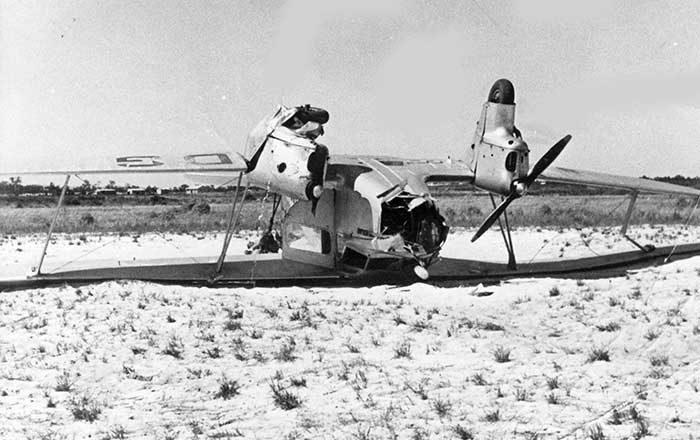
The name on the nose is now "Port Hedland". Photo: Geoff Goodall collection
| 18.10.37 | Built at Hatfield by De Havilland Aircraft Co Ltd. Production DH.90 |
| 28.10.37 | British CofA issued VH-UTJ: De Havilland Aircraft Pty Ltd, Sydney |
| Ordered by the Australian DH agents for customer North-Western Airlines Ltd, Moree NSW North-Western Airlines was founded at Moree in January 1937 by J.K.Richardson to provide the first air service linking Moree to Sydney. A DH.85 Leopard was first proposed but capital was over-subscribed by local investors, which allowed a twin-engined DH.90 to be purchased. Land was purchased and a new airfield with maintenance hangar constructed, before services could commence. | |
| Shipped to Australia | |
| 1.38 | Assembled at Mascot Aerodrome, Sydney by De Havilland Aircraft Pty Ltd |
| 28.1.38 | First test flight Mascot after assembly |
| 8.3.38 | J.K.Richardson commenced a tour of north western NSW towns in VH-UTJ, to promote other towns joining the Sydney-Moree service |
| 9.3.38 | Added to Register as VH-UTJ: North-Western Airlines Ltd, Moree NSW Prewar Australian registrations were allocated by CAB in strict sequence, with few exceptions. By 1938 allocations had completed the VH-U series and moved to the VH-A series. However CAB was issuing earlier unused registrations, as in this case. VH-UTJ had originally been reserved in 1935 for another aircraft, which failed to be registered. |
| 9.3.38 | CofA issued at Mascot |
| 12.3.38 | Flew at an air pageant held at the new Moree airfield to celebrate the new airline |
| 14.5.38 | Flew North-Western Airline's first service: Sydney-Scone-Tamworth-Gunnedah-Narrabri-Moree First company pilot was Flt Lt I.C.C. Thompson |
| 23.5.38 | Mail commenced being flown on the Sydney-Moree service. |
| 16.1.40 | Crashed on takeoff Moree NSW when port undercarriage collapsed. Pilot W.A.Hancock and 3 passengers unhurt. |
| 1.40 | North-Western Airlines hired Tugan Gannett VH-UVU from Airlines of Australia for 6 weeks as a replacement while DH.90 was being repaired |
| 3.10.40 | Change of ownership: Qantas Empire Airways Ltd, Brisbane Qld |
| 5.10.40 | Delivered
to QEA at Archerfield aerodrome, Brisbane. It was needed urgently to
replace DH.86 VH-USF which had been impressed from QEA for RAAF
use. |
| 24.10.42 | Damaged, while on charter to the US Army |
| 6.5.43 | Ground-looped
during landing at Breddan Qld due locked starboard brake. Port
undercarriage collapsed and main centre-section spar broken. Captain
G.T. Morgan. No injuries |
| 21.10.43 | Ground-loop
during landing at Townsville Qld. Port undercarriage collapsed and main
centre-section spar broken. Captain J. T. Kiernan and three
passengers on a charter flight for Allied Works Council. No injuries |
| 14.10.45 | Ground-loop during landing at Cloncurry Qld. Port undercarriage, propeller and lower wing badly damaged. Captain L. L. McNeill. Pilot reported that during landing roll the aircraft swung slightly to port but then violently to starboard. |
| 18.10.46 | Change of ownership: Edward J. Connellan, Alice Springs NT Eddie Connellan established Connellan Airways at Alice Springs in 1939 with Percival Gulls flying passengers and mail on remote outback routes through NT to Wyndham WA. VH-UTJ was the second twin-engined aircraft introduced after WWII. Connellan Airways aircraft were also used on contract for the Flying Doctor Service of Australia until 1965. |
| Delivered
to Alice Springs by QEA Captain W. Forgan-Smith. On arrival he endorsed
E.J. Connellan on the type, stressing techniques to avoid ground-loops | |
| 27.10.46 | Eddie Connellan made a forced landing at Nicholson Station, no damage. He later wrote: "Those British aircraft with two engines would not fly on one engine in central Australia. However VH-UTJ proved me wrong. I had an engine failure on the way from Nicholson Station to Gordon Downs early in the morning: my only passenger was Edith Clough. I tried to return to Nicholson on one engine but gradually lost height until I was flying in ground-effect. At one stage I decided to land on a patch of clear ground, about 30 miles from Nicholson, then suddenly found I was able to gain a little height, so battled on and managed to make a straight-in approach at Nicholson to land. The trouble was in the carburettor, once again it was necessary to evolve a modification to prevent a recurrence of the problem." |
| 26.11.47 | Annual CofA renewal at Bankstown NSW |
| 9.1.48 | Caught fire on the ground at Ammaroo NT. Fire damage to wings, nose, fuselage, cabin |
| Moved overland to Alice Springs for extensive rebuild by Connellan Airways | |
| 30.4.50 | CofA renewed at Alice Springs after rebuild. Airframe total time 5335 hrs |
| 17.7.50 | Swung
on landing at Hermannsburg NT, when a tyre burst. Port undercarriage
structure was bent and the wing spar was split. Pilot F. Ogden
unhurt. |
| 8.50 | Repaired on site at Hermannsburg |
| 1.2.51 | Change of owner's name: Connellan Airways Ltd, Alice Springs NT |
| 14.5.51 | Annual CofA renewal at Alice Springs. Airframe time 5,884 hrs |
| 2.3.52 | Ground-loop landing at Alice Springs, damaged |
| 9.5.52 | CofA renewed after repairs at Alice Springs. Airframe time 6,621 hrs |
| 5.6.53 | Annual CofA renewal at Alice Springs. Airframe time 7,401 hrs |
| 9.8.55 | Destroyed by fire while refuelling at Tennant Creek NT Eddie Connellan later wrote: "One of our Dragonflies was destroyed by fire at Tennant Creek during a refuelling operation, apparently caused by a leakage in the motorised refuelling equipment provided by the agent, not by the Shell Company. However the Shell Company were very generous and offered compensation. I claimed that the only suitable aircraft on the market in Australia was a Beechcraft 18 VH-KFD. They bought it for us!" |
| Compiler's note: It was in fact a significant break-through for Connellan, who had wanted Beech 18s since 1947. This had been continually refused on cost grounds by the Federal Government which paid a subsidy for his commercially-unviable outback services, but in return had frustrating control through the Department of Civil Aviation over aircraft types and operation of the airline. Instead of high performance all-metal Beech 18s, DCA dictated use of RAAF disposals DH.84 Dragons and Avro Ansons, both of which were quickly proven totally unsuitable. With the unplanned introduction of Beech C18S VH-KFD, Departmental opposition was dropped and Connellan acquired two more Beech 18s which improved all aspects of the airline. |
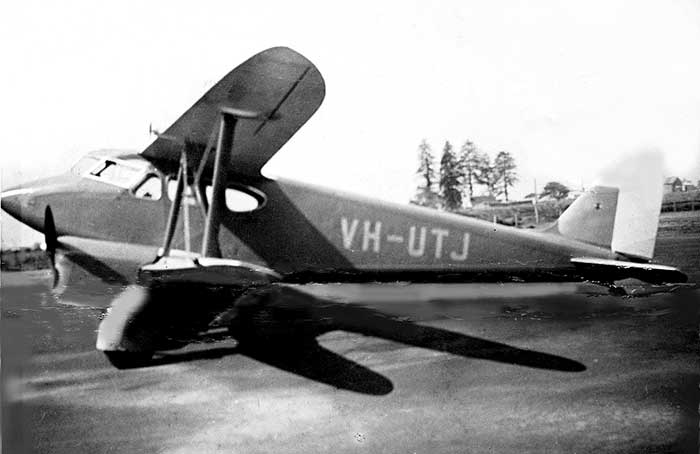
Civil Aviation Branch to be attached to its first CofA form. File held by National Archives of Australia
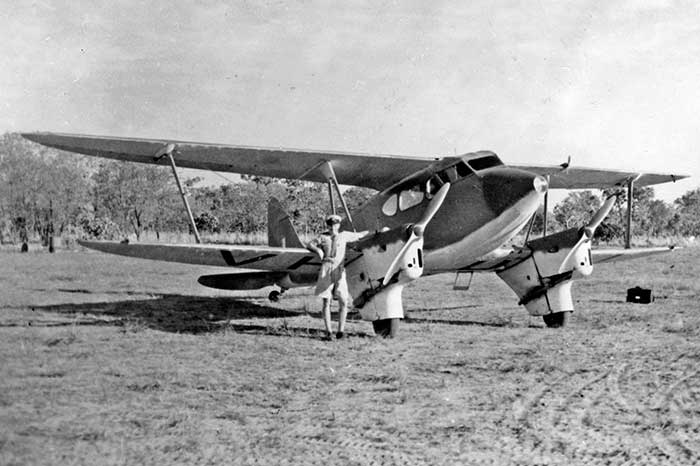
VH-UTJ painted in camouflage while in Qantas service in outback Queensland circa 1943,
with QEA Captain Bill Forgan-Smith. Photo: Qantas via Geoff Goodall collection
with QEA Captain Bill Forgan-Smith. Photo: Qantas via Geoff Goodall collection

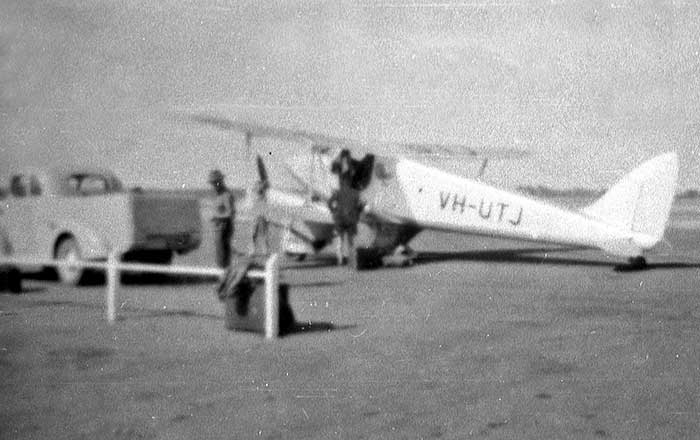
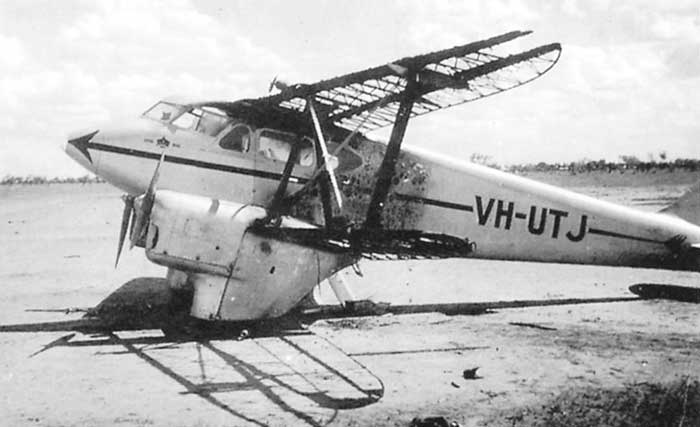
Photo by E.J.Connellan
| 6.36 | Built at Hatfield by De Havilland Aircraft Co Ltd. Production DH.90 |
| 9.5.36 | Registered G-AEDT: Rt .Hon. Sir Philip A. G. D. Sassoon, Park Lane, London At the time Sir Philip Sassoon was British Secretary of State for Air |
| 19.6.36 | First flight Hatfield |
| 22.6.36 | British CofA issued. Based at RAF Station Hendon, later Lympne aerodrome |
| .37 | Sold to Adastra Airways, Sydney, Australia |
| Shipped to Australia as boxed cargo | |
| 14.12.37 | CAB advised Adastra that registration VH-ABM was allocated to their Dragonfly. Adastra wrote to CAB: “You recently allotted registration VH-ABM to this aircraft but we understand from your Mascot office that the markings VH-AAD are at present available, and we should be glad to know if we can have the latter allotted to us instead of VH-ABM” |
| 2.38 | CAB agreed to change the allocation from VH-ABM to VH-AAD |
| 2.2.38 | Adastra Airways took delivery of the aircraft at Mascot Aerodrome, Sydney |
| 3.38 | Assembled at Mascot by Adastra |
| 17.3.38 | First test flight at Mascot after assembly, pilot L. J. Bruchhausen of Adastra Airways. Airframe log book: total flying time 396 hrs 45 mins |
| 17.3.38 | Australian CofA issued |
| 25.3.38 | Registered VH-AAD: Adastra Airways Pty Ltd, Mascot Aerodrome, Sydney Operated on Adastra Airways' daily return service Sydney-Bega NSW and later for aerial photographic mapping which Adastra pioneered the previous year. Postwar Adastra was reformed as Adastra Aerial Surveys and became Australia's leading photographic and mineral survey company: see www.adastron.com/adastra/default.htm |
| 20.1.39 | Forced landing on Gerringong Beach NSW while operating a Sydney-Bega scheduled service. Minor damage. Pilot Norm Rodoni and three passengers unhurt |
| 27.9.39 | Adastra
advised DCA that VH-AAD was dedicated to the Sydney-Bega service, and
the Waco VH-UYD had been released to operate the company's aerial
survey work. |
| 28.7.40 | Government subsidy for the
Sydney-Bega service was withdrawn due wartime restrictions. Adastra
replaced VH-AAD on the Bega service with the smaller BA Eagle VH-UUY |
| 24.8.40 | Adastra Airways ceased the scheduled airline service to Bega, the route being taken over by Butler Air Transport, Sydney |
| 8.40 | Dragonfly modified at Mascot for aerial photographic survey |
| 40-45 | During
WWII VH-AAD escaped impressed by the Government for RAAF because of its
value to the war effort by flying extensive aerial mapping for the
Australian military authorities, also reportedly for USAAF in
Australia. Its civil CofA was maintained throughout the war. |
| 28.5.42 | A new camera hatch was installed on the floor forward of the pilot's seat. |
| 16.6.42 | Flown
Mascot-Coolangatta
Qld by Adastra pilot Clarke, to commence an Australian Army Survey
Corps contract for photographic mapping survey of northern NSW.
Survey lasted for the rest of the year and also used Adastra Waco YKS-6
VH-UYD |
| 6.46 | VH-AAD
engaged on a large scale aerial mapping contract for the Government of
Victoria. Adastra also used several Avro Ansons on this survey. |
| 2.2.48 | Damaged on landing at Bankstown Aerodrome, Sydney |
| 6.48 | Returned
to the Victorian survey contract, to replace Adastra Anson VH-BGO
which was destroyed in a hangar fire at Nhill Vic. VH-AAD was based at
Ballarat and Nhill |
| 14.6.51 | Change of ownership: Bush Pilots Airways Pty Ltd, Cairns Queensland |
| 19.6.51 | Departed Sydney on delivery flight to Cairns, flown by Bob Norman who was the founder of Bush Pilots Airways |
| 23.6.51 | First
charter flight with Bush Pilots Airways: Bob Norman flew Cairns to
Georgetown taking manager of a local meatworks operation to a cattle
auction. |
| Operated
from Cairns on charters and medical emergency flights, often into
marginal bush strips and station properties through the Queensland
outback and Cape York Peninsula | |
| 2.11.51 | Propeller damaged at Cairns, pilot Bob Norman |
| 11.51 | Leased to Queensland Ambulance Transport Brigade, Cairns Qld to replace QATB's DH.89 Rapide VH-CFA which ditched into sea on an emergency flight 26.11.51 near Cairns |
| 11.52 | QATB lease ended when their replacement Rapide VH-CFA (2) arrived Cairns from England |
| 10.53 | Leased to Queensland Ambulance Transport Brigade, Cairns Qld to replace QATB's DH.89 Rapide VH-CFA (2) which also ditched in the sea near Cairns on an emergency flight 26.10.53. Both ditchings were caused by VFR navigation difficulties in severe smoke haze due to the seasonal burning of sugar cane crops for hundreds of miles along the coast. |
| 7.12.52 | Newspaper
report: Bush Pilots Airways Dragonfly flew Cairns-Mount Surprise
Station carrying officials to open a new airstrip at the property.
After arrival, the pilot Bob Norman received a message from QATB and
flew to Normanton and on to Mitchell River Mission to collect two
urgent medical cases to take to Cairns. He was forced to stay the night
at the mission before returning to Cairns next morning. |
| 4.54 | noted at Bankstown at the KSAS hangar. All silver with "B.P.A." insignia on tail |
| 25.11.54 | Change of ownership: Kingsford Smith Aviation Services Pty Ltd, Bankstown Aerodrome, Sydney NSW The Dragonfly was part trade-in to Auster dealers KSAS for an order of four new Auster J.5B Autocars VH-BPA to VH-BPD delivered the following year. |
| 8.6.56 | Change of ownership: Griffith Aero Club, Griffith NSW Used for twin engined pilot-training and as an emergency aerial ambulance when required |
| 8.63 | Change of ownership: Charles Masefield & Lord Trefgarne, London UK Charles Masefield was son of the distinguished British aviator Peter Masefield, who had been appointed Managing Director of the recently formed British Executive and General Aircraft Ltd (BEAGLE) which had absorbed Auster Aircraft to produce a range of more modern types. David, Lord Trefgane was aged only 23 when he took his seat in the House of Lords in 1962. The pair of friends had delivered a new Beagle Airedale G-ASBI from England to Adelaide in June 1963, and then stayed in Sydney assisting Airedale sales of local dealer Allied Aviation. While looking for an aircraft to fly back to England, they learnt that VH-AAD was available for sale at Griffith. |
| Demonstration
flight at Griffith by a Griffith Aero Club instructor with Masefield
and Trefgarne on board. The port engine failed just after becoming
airborne, instructor landed back on the runway but aircraft
ground-looped into scrub, without damage. Nevertheless Trefgarne
agreed to purchase the Dragonfly | |
| Masefield
ferried AAD from Griffith to Camden NSW, where it was to be given an
overhaul and prepared for the flight to England. The Gipsy Major I
engines were replaced by Gipsy Major 10s which gave an extra 10hp each side. A larger fuel tank from a DH Mosquito was installed bringing total fuel capacity to 175 gallons which gave a range of 1100 miles. Additional instrumentation and radio equipment (from Airedale G-ASBI) was installed in in the cockpit | |
| Just
prior to the overhaul commencing, Masefield and Trefgarne flew the
Dragonfly on a Royal Aero Club of NSW flying weekend to Newcastle and
Narrabri NSW | |
| 2.9.63 | Struck off Australian Register |
| 3.10.63 | Restored to British Register G-AEDT: David, Lord Trefgarne, Pembroke House, Chobham, Surrey. To be based at Shoreham |
| Maintenance completed at
Bankstown to prepare for the flight to England. Repainted as G-AEDT in Beagle Aircraft Ltd's house colours blue and white with gold trim and "Beagle" motif on the nose | |
| 2.11.63 | Named Endeavour in a ceremony at Bankstown |
| 21.11.63 | British CofA renewed at Bankstown |
| Lord Trefgarne gained his twin-engine endorsement on the DH.90 at Sydney | |
| To avoid Indonesian
airspace, the planned route was Brisbane, Mount Isa, Darwin, New
Guinea, Palau, Singapore then usual route to UK. However after much
delay, the Indonesian Government granted permission to land at Djakarta, so the more direct route to Singapore was taken. | |
| 1.12.63 | G-AEDT departed Bankstown to commence the flight to England, flown by Charles Masefield and Lord Trefgarne |
| 24.12.63 | Arrived at Gatwick Airport, London, receiving significant media coverage. They continued on to Shoreham the same day |
| 29.12.63 | G-AEDT noted at Shoreham. |
| .64 | Sold to Tallmantz Collection/ Movieland of the Air, Santa Ana, California |
| 5.64 | Dismantled during overhaul, fuselage at Shoreham and wings at Rearsby |
| 30.7.64 | G-AEDT
departed Gatwick on delivery flight to USA via the North Atlantic
route. Flown again by Peter Masefield and Lord Trefgarne |
| 31.7.64 | Departed Prestwick, Scotland for Iceland. Painted with Australia to England to USA, and still named Endeavour. Route was Stornoway, Reykjavik, Sondre Stromford, Goose Bay, Montreal, New York then California. |
| 5.8.64 | Arrived at New York |
| 8.64 | Placed on static display in the collection's open compound at Orange County Airport, Santa Ana CA |
| 8.64 | Registered N2304: Tallmantz Collection, Santa Ana CA US registration was never painted on the aircraft |
| 9.65 | noted at Orange County Airport in the Tallmantz compound of aircraft. It was still in the Beagle blue and white scheme and on its door is a winged kangaroo wearing a crown. |
| .66 | Tallmantz collection purchased by Rosen Novak Auto Co, Omaha, Nebraska The aircraft were left "as is" in the compound at Orange County Airport while individual sales were attempted at unreasoanbly high prices. |
| .66 | Advertised for sale in UK by Tallmantz, asking £8,000 |
| 29.5.68 | G-AEDT included in
the auction of entire Tallmantz Collection of 28 aircraft at Orange
County Airport. Ranged from Maurice Farman VH-UBC to WWI
fighters, a range of WWII aircraft and many rare civil aircraft. |
| 4.69 | Change of ownership: Joseph L. Terteling, Boise Idaho |
| Held in Joe Terteling's collection of 40 vintage aircraft and gliders at Glider Field, Boise ID. During the 1970s the aircraft fell into poor condition in ramshackle hangars. DH.90 was stored dismantled, covered in dust, still painted as G-AEDT | |
| 20.9.86 | Joe Tertling Collection auction sale: "One of the World's Finest Aircraft Collections" 42 aircraft and large collections of aero engines, propellers, spare parts, aerial cameras, library of aircraft manufacturer handbooks, 3 rooms of parts: rivets, instruments,tubing, tyres etc. Among aircraft for sale was ex Australian Genairco Cabin VH-UUI. Auction Catalogue quotes: DH.90 Dragonfly N2034 s/n 7508: two Gipsy Majors. It is disassembled and needs total restoration. This plkane was flown from Australia to England, then across thr Atkantic to US. An extremely rare plane, believed to be one of two remaining in the world. Has FAA title and registration. |
| Bidding
on the DH.90 was between representatives of a Canadian museum and three
British vintage aircraft restorers. Winning bid of $US41,000 was for
Brian Woodford | |
| 20.9.86 | Purchased at auction by British aircraft enthusiast Brian Woodford |
| 9.11.86 | Arrived England in a
container by ship. Moved by road to Southampton for rebuild by
experienced vintage aircraft restorer Ron Souch trading as The
Aeroplane Company, Sarisbury Green, Hampshire, near Southampton. The wings were restored but a completely new fuselage was constructed. |
| 27.4.87 | Restored to British Register G-AEDT: Brian Woodford t/a Wessex Aviation and Transport Ltd, Chalmington, Dorchester |
| 15.7.88 | First flight after rebuild, pilot Martin Barraclough |
| .96 | Sale negotiated to Colin Smith, Croydon Aviation Heritage Trust, New Zealand. Total hours since the rebuild: 58 hrs |
| 8.97 | Colin Smith went to England to dismantle G-AEDT at Cliff Lovell's hangar at Chilbolton. Packed in a shipping container and sent to NZ by sea |
| 12.9.97 | Nominal Change of ownership: Barry K. Donovan c/- Cathay Pacific Airways, Hong Kong |
| 19.12.97 | G-AEDT arrived in NZ in its container. |
| 23.3.98 | Struck-off British Register, sold to New Zealand |
| 1.4.98 | Registered ZK-AYR: Colin Smith trading as Croydon Aircraft Co Ltd, Mandeville airfield, Gore NZ |
| 7.4.98 | First flight at Mandeville after assembly |
| 1.05 | ZK-AYR has now flown 208 hours since the British rebuild |
| Current |
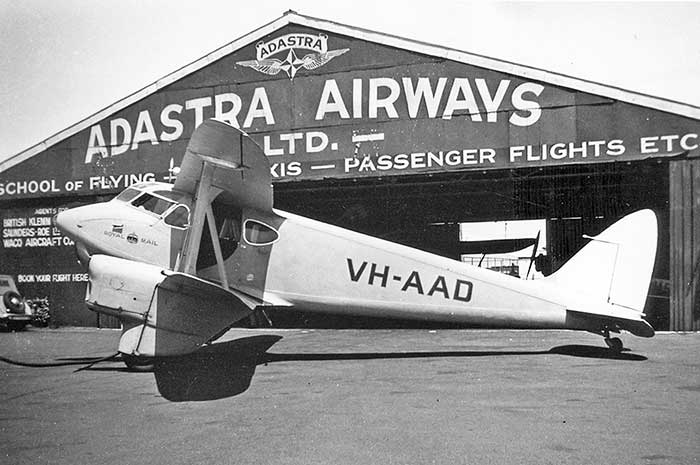
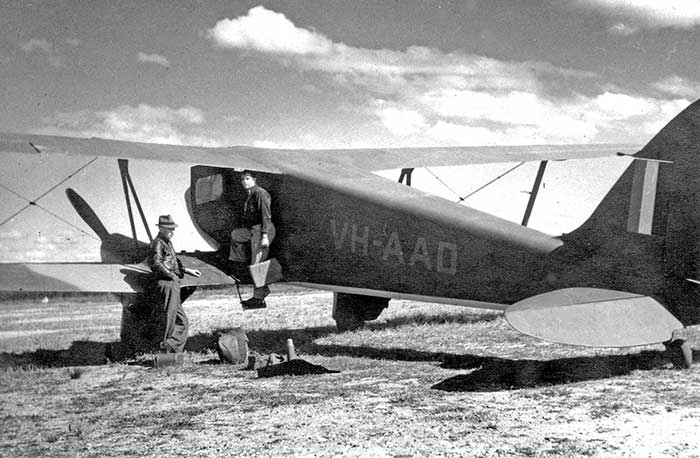
Bob Livingstone collection
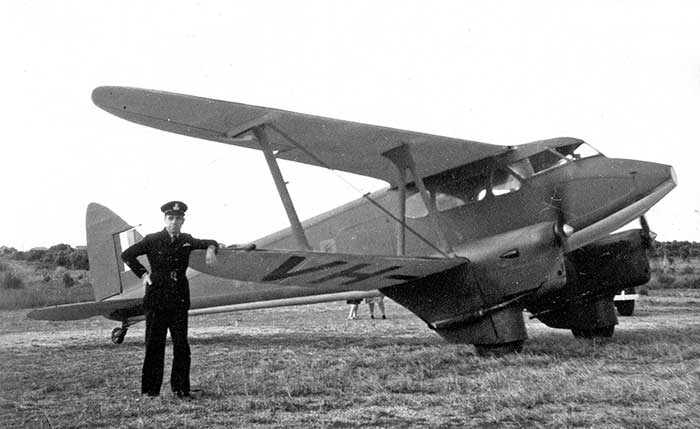
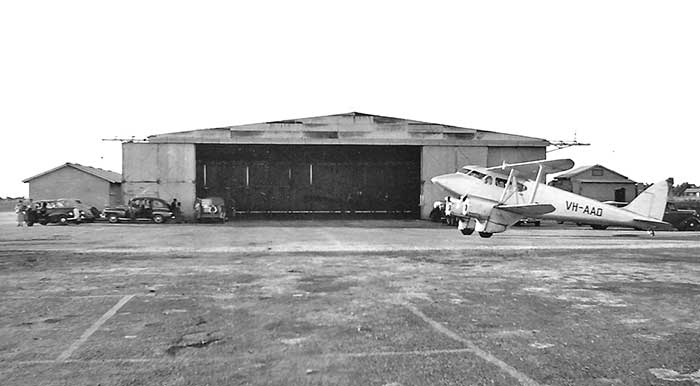
photographic survey of Victoria for the state government. Photo by Paul Miller
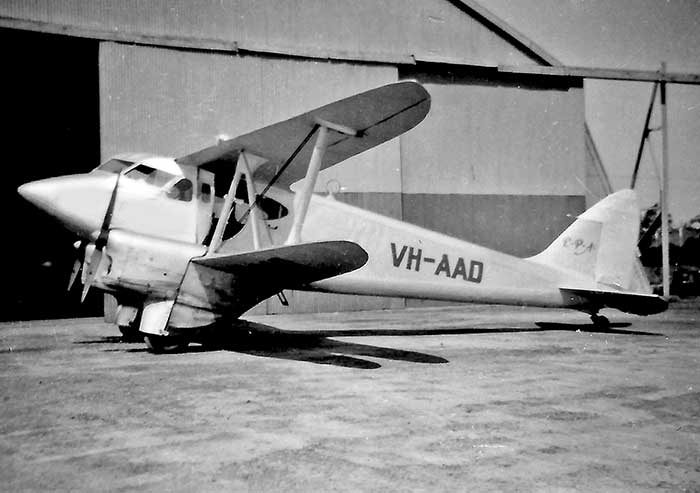
All silver with "B.P.A" in script on the tail. Photo by Ed Coates
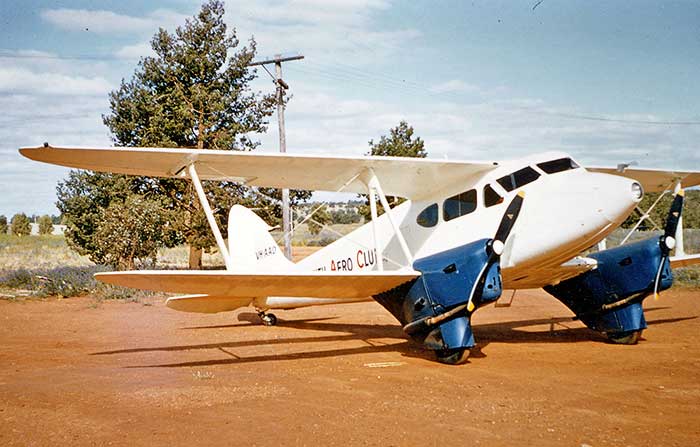
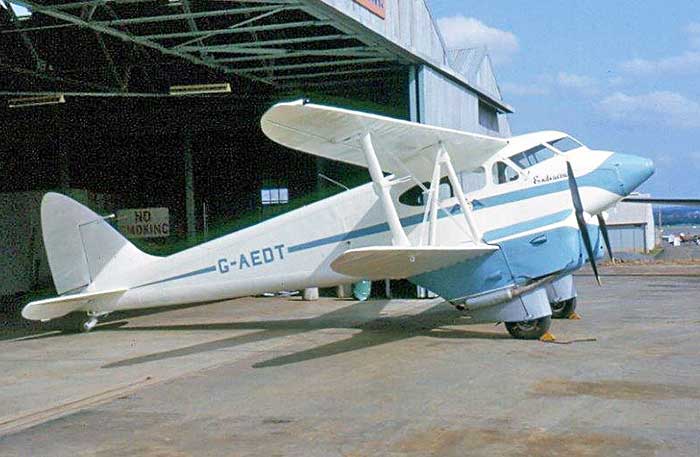
Photo by Dave Eyre
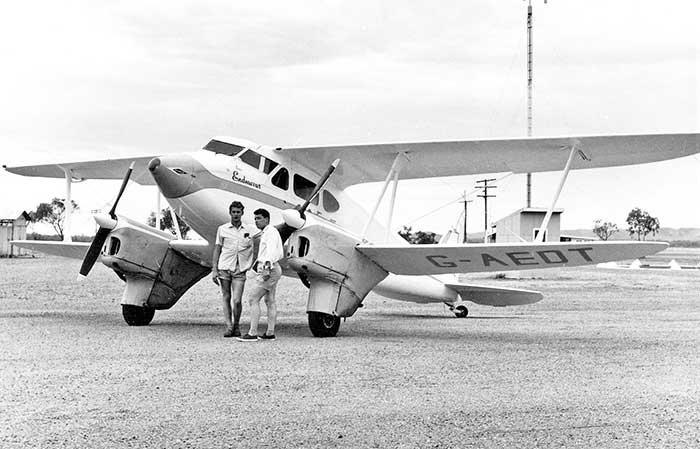
Charles Masefield (left) and Lord Trefgarne. Photo: Ben Dannecker collection
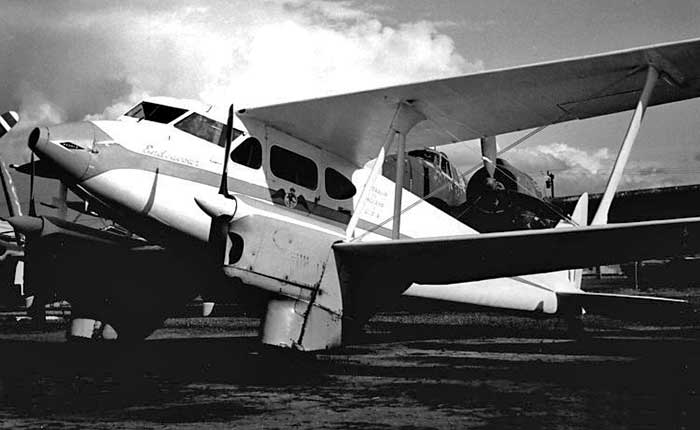
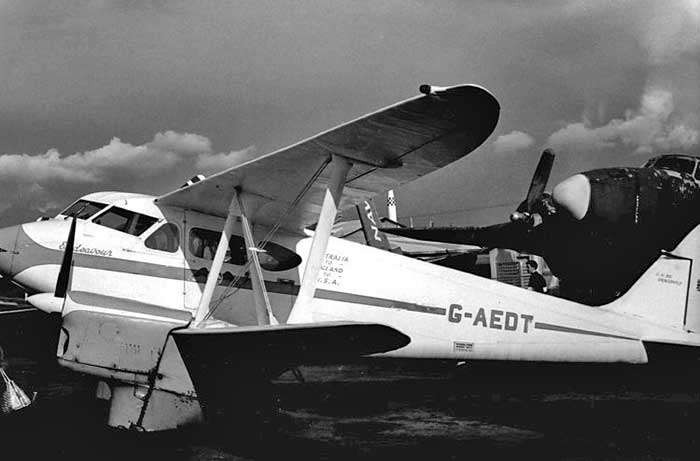
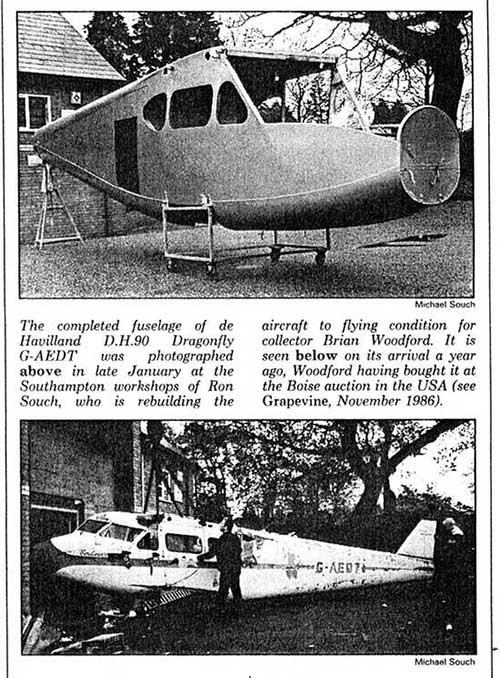
Aeroplane Monthly magazine April 1988 issue
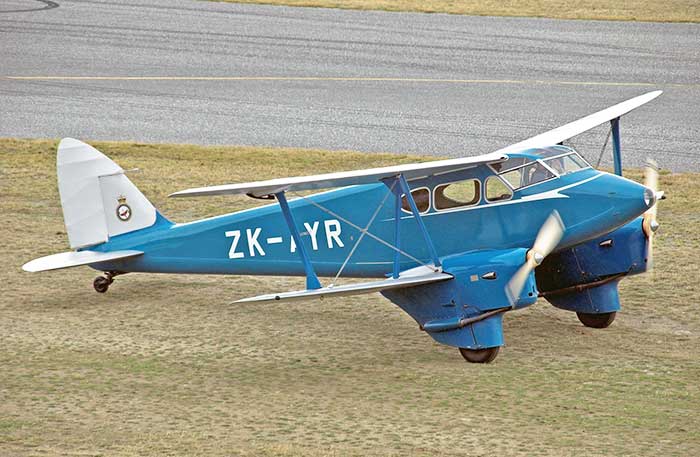
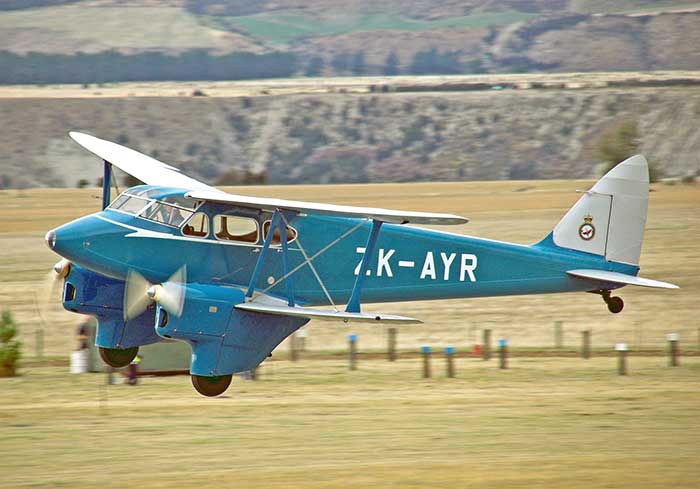
This photograph taken from an Adastra Aerial Surveys Avro Anson shows RAAF Ballarat Victoria in 1946 with rows of RAAF Avro Ansons lined up for sale by the Commonwealth Disposals Commission. Adastra's Dragonfly VH-AAD was based here at the time, engaged on the Victorian state survey contract. It can be seen parked outside the hangar at top centre. Ballarat was later handed over for civil use and
it is surprising how little of the layout has changed over the years.
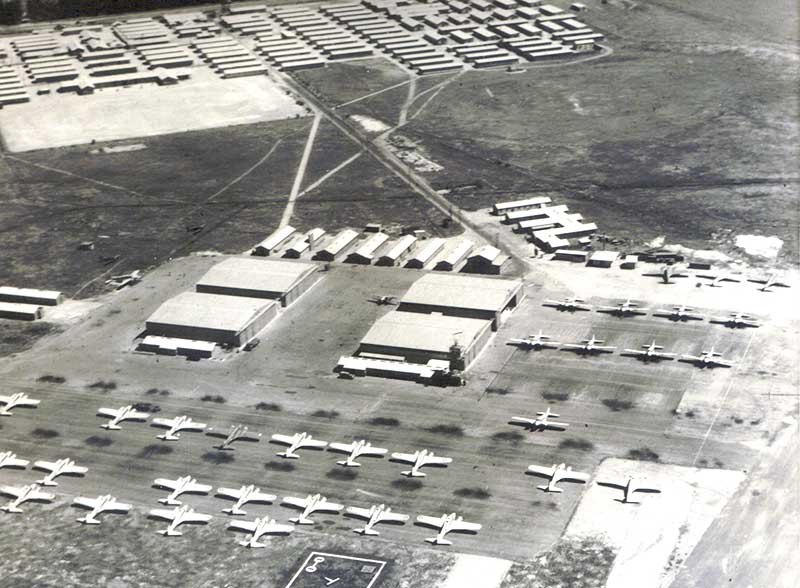
- Australian Civil Aircraft Register, Department of Civil Aviation and its successors
- DCA Aircraft files, National Archives of Australia, Melbourne & Perth
- RAAF Status Cards, RAAF Historical Section, Canberra (A43- series)
- National Library of Australia - Trove newspaper archive website
- British Civil Aircraft Register: G-INFO website
- British Civil Aircraft Since 1919, A. J. Jackson, Putnam, London 1973
- De Havilland Aircraft Since 1909, A. J. Jackson, Putnam, London 1978
- Flypast A record of Aviation in Australia, Neville Parnell & Trevor Boughton, CAA 1988
- Forgotten Flyer The Story of Charles W. Snook, Brian Hernan, Tangee Publishing 2007
- False Dawn - The Beagle Aircraft Story, Tom Wenham, Air Britain Publishing 2015
- Bush Pilot, Bob Norman, NormanEnterprises, Cairms Qld 1976
- Failure of Triumph, The story of Connellan Airways, Edward J. Connellan, self-published 1992
- 10,000 Hours, Harry V. Moss, Hesperian Press 1988
- Qantas at War, Hudson Fysh, Angus & Robertson, Sydney, 1968
- Historic Civil Aircraft Register G-AUAA to VH-UZZ, Bert Cookson, Austairdata 1996
- Air Britain publications 1948 to date: references to DH.90s
- Aviation Historical Society of Australia Journal, monthly journal 1960-70
- Australian Air Log, monthly journal, 1965-1968
- The Mackay Aerial Expedition 1937- use of Wireless, Dion Makowski, Man and Aerial Machines, quarterly No.29 May-June 1992
- Airlines and Aircraft of the Ansett Group 1921-2002, Fred Niven, Edition 9, 2013
- Classic Wings Downunder magazine, renamed Classic Wings: editor Graham Orphan: various references to DH.90s
- Flight Path magazine, Australia, editor Rob Fox, various references to DH.90
- Adastra Aerial Surveys site: www.adastron.com/adastra/default.htm: VH-AAD history:
- Under the Hammer, Roy Bonsor, Flypast magazine Sept 1968 & Oct 1968: Tallmantz auction
- Auction catalogue for Joe Terteling Collection sale at Boise Idaho 20.9.86
- British aviation magazine reports on the Terteling auction
- Connellan Airways fleet list: typed by Eddie Connellan, edited by Roger Connellan, courtesy Ben Dannecker